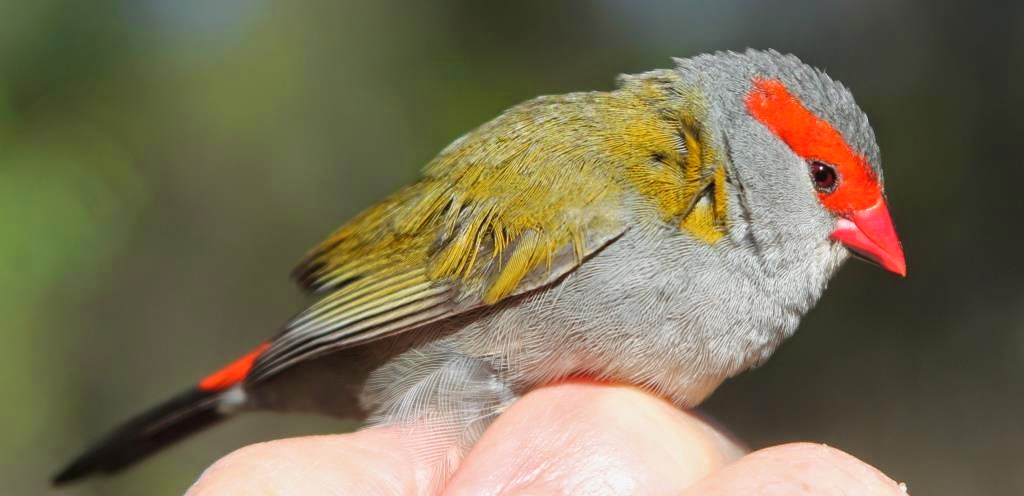On July 11 2014 Warren Thompson and Val and I travelled along the Old Glen Innes Road which runs from Waterview Heights to near the correctional centre (prison farm), east of Glen Innes. It had been the main road between the two cities prior to the early 1970s when the Gwydir Highway was constructed and the Gibraltar Range National Park was dedicated. Warren was keen to have a look at a Travelling Stock Reserve (TSR) at Dalmorton and we were keen to check out the road as we hadn't travelled it for some time.
Departing Coutts Crossing was a real effort as we kept observing interesting birds which was also the problem along the back road into South Grafton (Gerygarrow and Rushforth Roads). Brothersons Swamp at Coutts Crossing was almost dry but it had a pair of Black-necked (Satin) Storks, a Yellow-billed Spoonbill, a lone Pink-eared Duck, four Black-fronted Dotterels and one Red-kneed Dotterel, as well as the usual suspects.
 |
| Adult female Black-necked Stork, Brothersons Swamp |
A stop along Rushforth Road yielded Azure Kingfisher, Comb-crested Jacana, Wedge-tailed Eagle and Straw-necked Ibis. By the time we reached South Grafton we had notched up 53 bird species.
 |
| Azure Kingfisher Rushforth Road |
 |
| Straw-necked Ibis, Rushforth Road |
We finally reached the start of the Old Glen Innes Road at Waterview Heights and called in at the Chambigne Creek TSR, a few kilometres along the road. It is a rich area for bush birds, such as the Golden Whistler, but species of large forest owl and the Black Bittern have also been observed there. By the time we left the Reserve we had 65 bird species.
 |
| Adult male Golden Whistler, Chambigne Creek TSR |
We spent some time looking at the TSR at Dalmorton, which adjoins the Guy Fawkes River State Conservation Area. The Boyd River runs through the Reserve and parallels the old road for many kilometres.
 |
| Boyd River, Dalmorton TSR |
The rest of the trip only yielded a small number of additional bird species but the scenery, including the 19th century tunnel, and mammal sightings made it worthwhile. In particular a mob of 5 Whiptail Wallabies, (sometimes called Pretty-faced Wallaby) at the Mann River Nature Reserve were a wonderful sight. This is one of the most beautiful of our macropod species.
 |
| 19th century tunnel |
The sun had set as were drove past the Washpool National Park turnoff and we were lucky enough to see a Parma Wallaby, a species that was considered extinct some years back. A Tawny Frogmouth in the adjacent Gibraltar Range National Park was the only nocturnal bird that we saw.
 |
| Adult Whiptail Wallaby, Mann River Nature Reserve |
A total of 84 bird and 5 mammal species were recorded for the day. No reptiles or amphibians were recorded due to the time of the year and the resultant low temperatures.
The full species list is as follows:
Birds: Black Swan, Australian Wood Duck, Pink-eared Duck, Grey Teal, Pacific Black Duck, Hardhead, Australasian Grebe, *Spotted Dove, Crested Pigeon, Bar-shouldered Dove, Wonga Pigeon, Tawny Frogmouth, Australasian Darter, Little Pied Cormorant, Little Black Cormorant, Australian Pelican, Black-necked Stork (T), White-necked Heron, Eastern Great Egret, Cattle Egret, White-faced Heron, Australian White Ibis, Straw-necked Ibis, Royal Spoonbill, Yellow-billed Spoonbill, White-bellied Sea-Eagle, Whistling Kite, Wedge-tailed Eagle, Dusky Moorhen, Eurasian Coot, Black-winged Stilt, Black-fronted Dotterel, Red-kneed Dotterel, Masked Lapwing, Comb-crested Jacana (T), Galah, Long-billed Corella, Rainbow Lorikeet, Eastern Rosella, Azure Kingfisher, Laughing Kookaburra, White-throated Treecreeper, Brown Treecreeper (T), Superb Fairy-wren, Red-backed Fairy-wren, White-browed Scrubwren, Brown Gerygone, Brown Thornbill, Spotted Pardalote, Striated Pardalote, Eastern Spinebill, Lewin’s Honeyeater, Yellow-faced Honeyeater, Fuscous Honeyeater, Bell Miner, Noisy Miner, Little Wattlebird, Brown Honeyeater, White-throated Honeyeater, White-naped Honeyeater, Blue-faced Honeyeater, Black-faced Cuckoo-shrike, Golden Whistler, Rufous Whistler, Grey Shrike-Thrush, Grey Butcherbird, Pied Butcherbird, Australian Magpie, Pied Currawong, Grey Fantail, Willie Wagtail, Raven sp. Torresian Crow, Magpie-lark, Jacky Winter, Rose Robin, Eastern Yellow Robin, Silvereye, Welcome Swallow, Tree Martin, *Common Myna, Mistletoebird, Double-barred Finch, Red-browed Finch.
Mammals: Eastern Grey Kangaroo, Whiptail Wallaby, Red-necked Wallaby, Parma Wallaby (T), Swamp Wallaby.






















